PURPOSE This study aimed to prove the mediator effect of skill level on participation frequency and injury level of leisure sports players with the highest injury rate. METHODS Raw data of the “2019 Sports Safety accident data” conducted by the Korea Sports Safety Foundation were used for this study. We analyzed 857 leisure sports players participating in events with the top four highest injury rates (Basketball, Soccer, Baseball/Softball, Foot Volleyball). Frequency, descriptive statistics, and correlation analyses using SPSS version 27.0 and Process macro model 4 were employed for analysis. RESULTS The results regarding participation frequency, injury severity, and skill level among recreational athletes are as follows. First, a positive correlation was established between the participation frequency of recreational athletes and their skill levels. Second, the correlation between participation frequency and injury severity was observed only in soccer and basketball. Third, skill level plays a mediating role in the relationship between participation frequency and injury level. The results indicate that as the participation frequency among leisure sports players who participate in ball sports with a high injury rate increases, this affects the degree of injury. CONCLUSIONS Skill level appears to play a mediating role in the relationship between participation frequency and injury level. Based on the results, we recommend safety education not only on the relationship between participation frequency and injury level, but also the intermediary role of skill level.
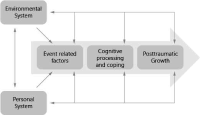
[Purpose] This study attempted to provide a literature review of the research on posttraumatic growth and to propose a revised model which mainly explain the relationships among serious leisure, posttraumatic growth, health, and happiness. The concept of psychological growth following a traumatic life event is most commonly referred to as posttraumatic growth in the literature and was first coined by Tedeschi and Calhoun (1995). It can be postulated that such experiences can lead to a richer appreciation for life, more compassion for others, closer relationships with others, better understanding of one's potentials and possibilities, and stronger religious faith. [Methods] The purposes of this study were achieved by (1) reviewing the posttraumatic growth and its relationship to serious leisure; (2) analyzing recent posttraumatic growth related models; and (3) proposing a revised posttraumatic growth model and a research agenda to further progress posttraumatic growth research. [Conclusions] Although there is an abundance of evidence for the existence of posttraumatic growth, its nature as well as benefits in relation to participation in serious leisure remain very partially understood. This study proposes a revised model for understanding the process of porsttraumatic growth in which serious leisure and cognitive processing play a significant role. Important implications of the relationships between serious leisure and posttraumatic growth are mainly discussed, alongside recommendations for future research.



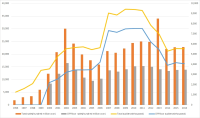
Purpose This research analyzed the Korean and Japanese cycle racing businesses by comparing each country’s total profits and total audience from 1996 to 2016. Methods In this process, it used total profits data and total audience data from 1966 to 2016. The data showed an economic correlation between Korean and Japanese cycle racing businesses by using each county’s economic variables. Results According to regression analysis, the income and audiences of Korean cycle racing industry has been increased as their income level has been increased. However, Japanese cycle racing generally has negative effects between income level and other variables except audiences. Moreover, aging population affects negatively to Korean cycle racing industry. In contrast, aging population is less affects to Japanese cycle racing industry. Furthermore, improvement of employment and unemployment rate affects negatively to Korean cycle racing industry. As a result, Korean cycle racing industry looks like a gambling. On the other hands, Japanese cycle racing industry becoming one of leisure sports industry. Conclusions Korean cycle racing industry has to examine closely Japanese’s restructuring method & result. Also, they have to analyze closely Japanese’s sociocultural variables which explain decreasing profits and increasing audiences. In other words, Korea cycle racing industry needs to various methods to becoming leisure sports industry.

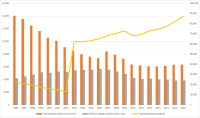
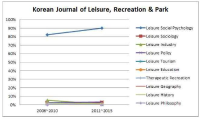
This study identified the trends in leisure and recreation research in Korea for the past 10 years. We classified previous research based on ten leisure and recreation research areas and compared the research trends of five journals: Korean Journal of Leisure, Recreation & Park, Korean Journal of Physical Education, Journal of Sport and Leisure Studies, Journal of Leisure Studies, and Journal of the Korea Contents Association. The results indicated that most research published over the last decade were included in the area of leisure social psychology, and the area of leisure social psychology showed the highest ratio in five journals compared with other research areas. To resolve the problematic results, this research suggests that future research needs to have diversity to extend the leisure and recreation research realm and to improve the quality of leisure and recreation research in Korea. We expect that this study would be used as a foundation for future leisure and recreation research.

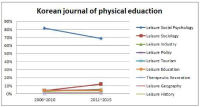

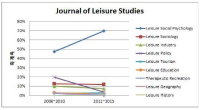
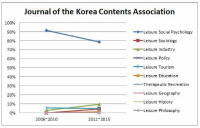
PURPOSE This study seeks to explore the subjectivity regarding leisure constraints perceived by college student-athletes. METHODS Based on Q methodology as an analysis framework, 25 Q-samples and 25 P-samples suitable for the research purpose were selected, and Q-classification and Q-factor analysis were conducted. RESULTS The leisure constraints were categorized into “Type Ⅰ: Psychological constraints,” “Type Ⅱ: Financial constraints,” and “Type Ⅲ: Spatio-temporal constraints.” The three types provided discussions on “strong athlete identity of student-athletes,” “role conflict between students and athletes,” “core competencies of student-athletes,” “current student-athlete support project,” and “school sports camp training.” CONCLUSIONS College student-athletes’ leisure constraints are closely related to strong athlete identity, anxiety about enjoying leisure, cost burden, and closedness of camp training, and each type provided new perspectives on discussions related to Korean student-athletes.
PURPOSE This study aimed to explore ways to utilize augmented reality (AR) in school sports and leisure by examining the case of an elementary school sports club using augmented reality-based e-sports. METHODS A self-study approach and Eisner's(1995) educational criticism were utilized. Data including photos, videos, literature, and memory boxes related to the elementary school AR sports club were collected weekly during the school semesters from March 2023 to January 2024, spanning a total of 30 weeks. The data were analyzed following the stages of analysis by Elo & Kyngäs(2007). RESULTS Augmented reality can act as a personalized exercise coach by visualizing physical activity information. Through posture and movement analysis, education on physical strength and expression can be provided that is linked to home; it can also expand the range of sports experiences and create a new sports culture. In order to effectively utilize AR, edtech field experts must be trained, and content must be developed through cooperation between companies and schools. The educational effectiveness of the content must be verified and the management system must be inspected, and public facilities utilizing edtech must be expanded. CONCLUSIONS AR has endless development potential in school sports and leisure, but these will require active interest and support from educational authorities.
Purpose This study focuses on accessibility to sports facilities that can be classified into structural leisure constraints. The purpose of this study is to explore exploratory analysis of the types of reservation methods and payment methods, which are the initial stages of consuming sports facilities, and to explore inconveniences that consumers feel when making reservations. Methods A quantitative research method was used to derive the results, and data were collected through a questionnaire survey method. The collected data were analyzed by technical statistics focusing on the reservation method, payment method, and inconvenience during reservation. Results As a result, it was found that the main types of reservation methods and payment methods were homepage, homepage/telephone, telephone, homepage/app, and account transfer and card payment, respectively. In the case of inconvenience, the procedure was complicated, address and location, and reservation method were identified as the main matters. Conclusions Efforts must be made to secure both the convenience and publicity of accessibility at an early stage, such as reservation methods and payment methods for sports facilities.
PURPOSE This study identified a company sports club’s dual characteristics— both for leisure activity and as an extension of work—to provide comprehensive interpretation and understanding of such clubs. METHODS A qualitative case study design was employed, incorporating in-depth interviews, nonparticipant observation, and supplementary data collection from 25 office workers who had participated in an in-house sports club for at least one year. RESULTS Participants reported a wide spectrum of motivations, from voluntary motives such as stress relief and health improvement to more obligatory or organizationally driven motives, including pressure from supervisors or colleagues and expectations related to performance evaluations. The club offered both team sports—which fostered teamwork and a sense of belonging—and individual sports—which offered personal development opportunities. However, some participants experienced blurring of work–leisure boundaries and reemergence of hierarchical organizational culture, leading to conflict and fatigue. CONCLUSIONS Overall, Although company sports clubs have become a welfare program that provides employees with opportunities for leisure and self-development and promote inter-departmental communication and collaboration, they also carry the latent risk of imposing additional burdens and pressures on employees. These findings underscore the need for refined operational strategies and institutional improvements to mitigate negative outcomes and maximize such programs’ original intent.
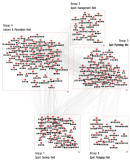
To examine the flow of knowledge structure in Korean journals of sport and social sciences over the last 10 years, this study has derived a knowledge map by conducting community analysis, one of the social network analysis methods, on Korean Journal of Sports Industry Management, Korean Journal of Sport Pedagogics, Korean Journal of Sport Sociology, Korean Journal of Sport Psychology and Korean Journal of Leisure and Recreation. According to the analysis result, the integrated knowledge map for the field of sport and social sciences was classified into 5 groups and these groups were derived to be similar to the knowledge structure of the keyword groups for the research topics of the five journals targeted by this study. Along with this result, at the same time, it has been confirmed that most of the groups shared keywords with each other. Especially, some of the keywords for the research topics of sports industry management have transferred to the research topics of leisure and recreation and those of sport sociology. Sport sociology has been revealed to be closely related to sports industry management and sport psychology. In the case of sport psychology, it has been confirmed that it is related to most of the other groups and the psychological variables for understanding human behavior can be widely used. It shows that leisure and recreation is highly related to sport psychology and sport management in terms of keywords for research topics but it is suggested that it also needs its own independent research topics. Sport pedagogics, by its nature, is an isolated field but interacts with sport psychology and attempts can be made to expand its research topics through an approach based on the concept of pedagogy for physical education.

The aim of this study is to analyze the correlation between per capita GDP and sports items' demand and to estimate the income elasticities of sports items' demand based on the International Social Survey Programme: Leisure Time and Sports - ISSP 2007 of the GESIS(Leibniz-Institute for the Social Sciences, Germany). The facts found from the analyses are as follows; First, in general, when the correlation coefficient of a particular sports item turns out to be both positive and statistically significant, the item can be interpreted to have a good possibility to be a luxury goods and when the coefficient is ascertained to be both negative and statistically significant, the item can be inferred to have a considerable chance to be an inferior goods. In this study, other team sports(excluding basketball, soccer, volleyball, baseball etc.), squash, walking/trekking/climbing, boat sports, hunting/fishing, horse riding/horse racing, motor sports, shooting, and snow sports were confirmed to show a luxury goods' features and basketball, soccer, volleyball, athletics, and martial arts were identified to have an inferior goods' characteristics. Second, similar to the results of the correlation analysis, in the income elasticities estimation, cockfighting appeared to be an inferior goods and other team sports, squash, walking/trekking/climbing, bowling/curling/bocce, boat sports, darts, hunting/fishing, golf/minigolf, horse riding/horse racing were proved to be a luxury goods.